Dukung anak Shoot
Phyllanthus urinaria L.
Phyllanthaceae



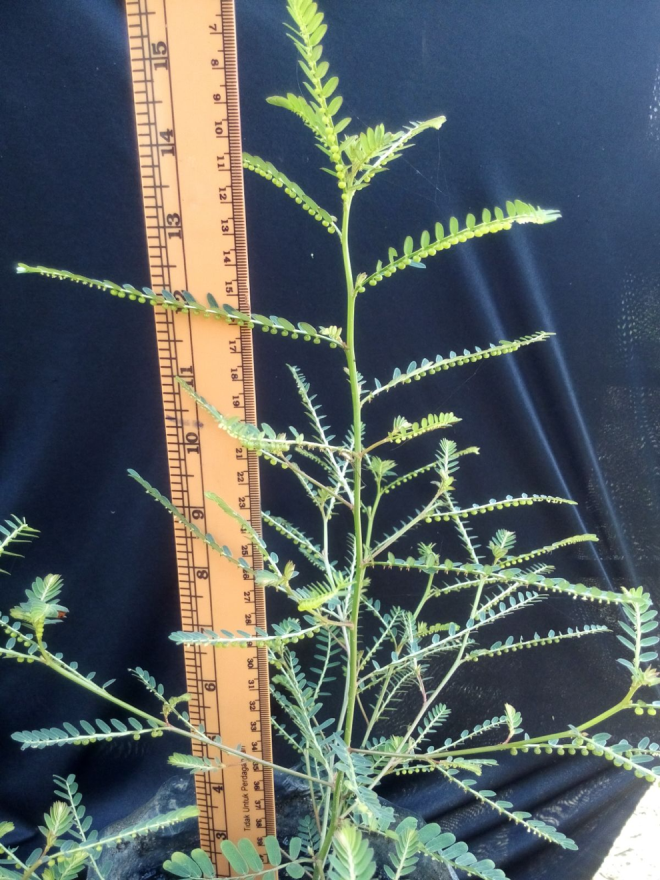
Figure 1 : Phyllanthus urinaria. (a)-(b) Shoot; (c) flowers; (d) matured plant bearing fruits. (Photos courtesy of Mohd Fauzi Sayuti, UKM, 2015)
DEFINITION
Dukung anak shoot consists of the powder of dried shoot of Phyllanthus urinaria L. (Phyllanthaceae).
SYNONYM
Diasperus urinaria (L.) Kuntze, Phyllanthus alatus Blume, Phyllanthus cantoniensis Hornem, Phyllanthus croizatii Steyerm, Phyllanthus echinatus Buch.-Ham. ex Wall., Phyllanthus lauterbachianus Pax, Phyllanthus leprocarpus Wight, Phyllanthus mauritianus Henry H.Johnst., Phyllanthus muricatus Wall., Phyllanthus nozeranii Rossignol & Haicour, Phyllanthus rubens Bojer ex Baker, Phyllanthus urinaria var. laevis Haines, Phyllanthus urinaria var. oblongifolius Müll.Arg, Phyllanthus urinaria subsp. urinaria, Phyllanthus verrucosus Elmer [ 1 ].
VERNACULAR NAMES
Carry me seed, black catnip, stone breaker, seed on the leaf, child-pick-a-back (English); dukung anak, meniran, rami buah (Malay); zen chu cao, ye xia zhu (Chinese); keela nelli, kilanelli (Tamil) [ 2 , 3 , 4 , 5 ].
CHARACTER
| Colour | Brownish-green |
| Odour | Slight odour |
| Taste | Bitter taste |
IDENTIFICATION
Plant Morphology
Phyllanthus urinaria is a monoecious, annual or short-lived perennial herb, erect or sprawling, up to 60 cm tall, reddish; branchlets (3–)5–13 cm long, flattened, often slightly winged and sparsely hairy. Leaves alternate, distichous and crowded along lateral branchlets, simple, glabrous, sessile; stipules ovate to lanceolate, long-acuminate, those of main sterna with auricles at base; blade oblong to elliptical oblong, 7–12(–20) mm x 3–6(–9) mm, base cuneate to rounded and slightly unequal, apex rounded, often pointed, margins finely toothed. Flowers 1–2 in the axils of leaves, male flowers towards the apex or branchlets, female flowers at the basal part of branchlets, unisexual, regular, 6-merous; pedicel c. 1 mm long; male flowers with obovate perianth lubea c. 1 mm long, disk lobes 6, stamens 3, filaments fused, anthers free; female flowers with triangular-ovate perianth lobes c. 1 mm long, disk cup-shaped, ovary superior; ovoid, warty, 3-belled, styles fused at base into a triangular plate, 2-fid at apex. Fruit a globular capsule 2–2.5 mm in diameter, usually warty, hanging, 6-seeded. Seeds c. 1 mm long, with sharp transverse ridges. [6]
Microscopy
Powdered material consists of abaxial and adaxial epidermal cells, stomata, fibres, spiral vessels, pollen grains, mesophyll sponge cells, sclereids, drusses, stem epidermis and parenchyma cells.
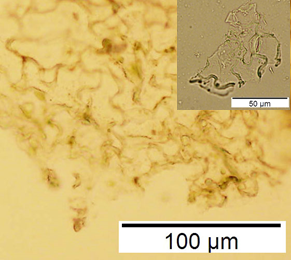

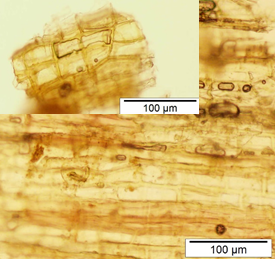

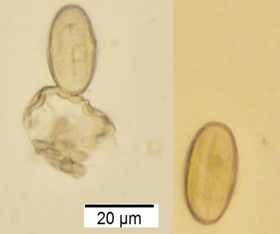
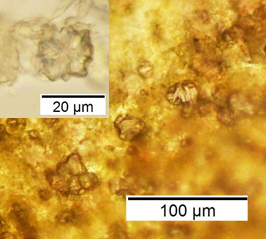

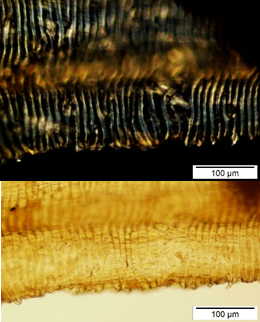


Figure 2 : Microscopic characters of dried Phyllanthus urinaria shoot powder of 0.106 mm size. (a) Sinuous anticlinal wall on abaxial epidermis (magnification 200x) and anomocytic stomata (magnification 400x); (b) straight to curve anticlinal wall on adaxial epidermis (magnification 200x); (c) stem epidermis (magnification 200x); (d) spiral vessel (magnification 400x); (e) pollen grains (magnification 600x); (f) drusses (magnification 600x and 200x); (g) sclereids (magnification 100x) and brachysclereids (magnification 200x); (h) sclereids in fruit part under light microscope and polarized filter (magnification 400x); (i) mesophyll sponge cells (magnification 400x); (j) fibres (magnification 400x). [Scale bars: a = 50 and 100 µm; b, c=100 µm; d = 50 µm; e = 20 µm; f = 20 and 50 µm; g = 100 and 200 µm; h = 100 µm; I = 50 µm; j = 200 µm].
Chemical Tests
Observation of solution after treatment with various reagents:
| Test for the presence of steroids | Bluish green |
| Test for presence of phenolics (tannins) | Bluish green |
Thin Layer Chromatography (TLC)

Figure 3 : HPTLC chromatogram mixture of phyllanthin and hypophyllanthin (S) and ethanol extract of dried Phyllanthus urinaria shoot powder (L) observed under visible light after derivatisation.
| Test solution | Weigh about 5.0 g of dried P. urinaria shoot powder in a screw-capped conical flask. Add 50 mL of ethanol into the flask and shake the mixture for 30 min and filter. Evaporate the filtrate to dryness over a water bath. Reconstitute with 5 mL of methanol. Filter the mixture through a 0.45 μm syringe filter and use the filtrate as the test solution. |
| Standard solution | Dissolve mixture of phyllanthin and hypophyllanthin standard in methanol to produce phyllanthin and hypophyllanthin standard concentration 1.0 mg/mL. |
| Stationary phase | HPTLC glass silica gel 60 F254, 20 x 10 cm |
| Mobile phase | Toluene : ethyl acetate; (2 : 1) (v/v) |
| Application |
|
| Development distance | 8 cm |
| Drying | Air drying |
| Detection |
|
High Performance Liquid Chromatography (HPLC)
| Test solution | Weigh about 5.0 g of dried P. urinaria and aerial powder in a screw-capped conical flask. Add 50 mL of ethanol into the flask and shake the mixture for 30 min and filter. Evaporate the filtrate to dryness over a water bath. Reconstitute with 5 mL of methanol. Filter the mixture through a 0.45 μm syringe filter and inject into HPLC column. |
| Standard solution | Dissolve mixture of phyllanthin and hypophyllanthin standards in methanol to produce phyllanthin and hypophyllanthin standard solution at concentration of 0.5 mg/mL each. |
| Chromatographic system | Detector : UV 230 nm
Column : C8 4.6 X 150 mm, 5 µm (Zorbax Eclipse Plus, if necessary) Column oven temperature : Ambient Flow rate : 1 mL/min Injection volume : 20 µL |
| Mobile phase (isocratic mode) | Acetonitrile : water; (45 :55) (v/v) |
| Run time | 25 min |
| System suitability requirements |
Perform at least five injections of mixture of phyllanthin (0.5 mg/mL) and hypophyllanthin (0.5 mg/mL) standard solution. The requirements of the system suitability parameters are as follow:
|
| Acceptance criteria |
|

(a)
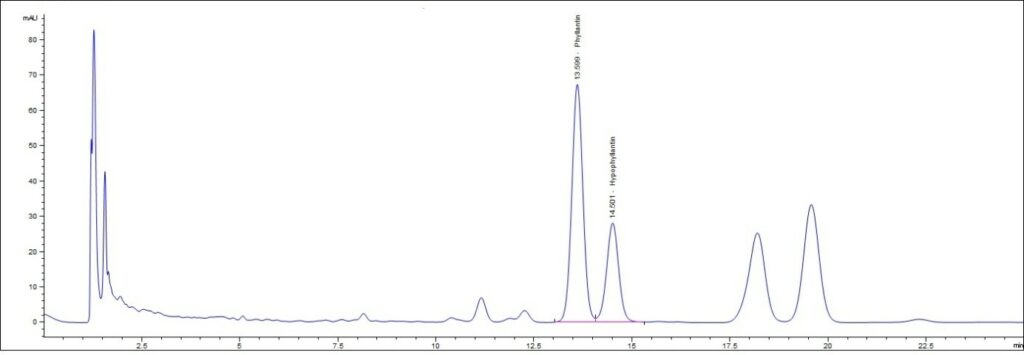
(b)
Figure 4 : Whole HPLC chromatogram of (a) a mixture of phyllanthin and hypophyllanthin standard solution (0.5 mg/mL) at tr = 13.634 min for phyllanthin and tr = 14.609 min for hypophyllanthin and (b) ethanol extract of dried Phyllanthus urinaria shoot powder showing peak corresponding to the mixture of standard solution at tr = 13.599 min for phyllanthin and tr = 14.501 min for hypophyllanthin.

(a)

(b)
Figure 5 : HPLC chromatogram highlighting the elution region of phyllanthin and hypophyllanthin in (a) a mixture of phyllanthin and hypophyllanthin standard solution (0.5 mg/mL) at tr = 13.634 min for phyllanthin and tr = 14.609 min for hypophyllanthin and (b) ethanol extract of dried Phyllanthus urinaria shoot powder showing peak corresponding to the mixture of standard solution at tr = 13.599 min for phyllanthin and tr = 14.501 min for hypophyllanthin.
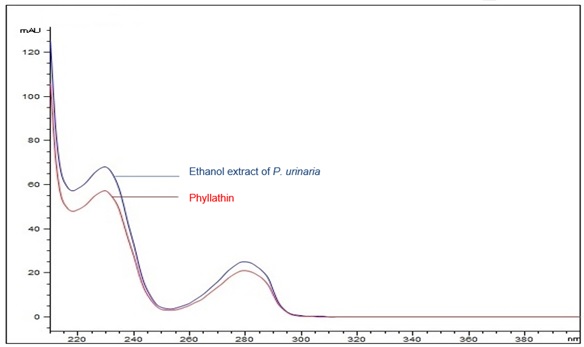
Figure 6 : UV spectrum of phyllanthin standard solution (0.5 mg/mL) and ethanol extract of dried Phyllanthus urinaria shoot powder.
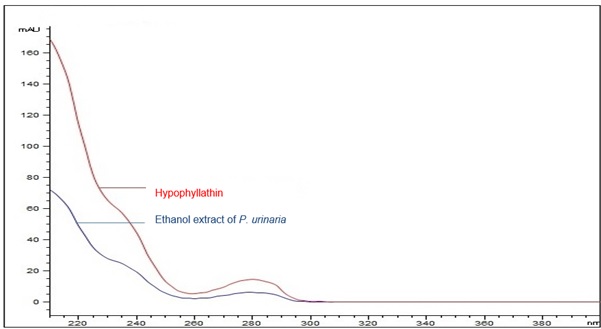
Figure 7 : UV spectrum of hypophyllanthin standard solution (0.5 mg/mL) and ethanol extract of dried Phyllanthus urinaria shoot powder.
PURITY TESTS
The purity tests except foreign matter test are based on dried P. urinaria shoot powder of 0.106 mm particle size.
| Foreign Matter |
| Not more than 2% |
| Ash Contents | |
| Total ash | Not more than 14% |
| Acid-insoluble ash | Not more than 2% |
| Water soluble ash | Not less than 2% |
| Loss on Drying |
| Not more than 16% |
| Extractive Values | |
| Water-soluble extracts | |
| Hot method | Not less than 16% |
| Cold method | Not less than 13% |
| Ethanol-soluble extracts | |
| Hot method | Not less than 3% |
| Cold method | Not less than 2% |
SAFETY TESTS
The safety tests are based on dried P. urinaria shoot powder of 0.106 mm particle size.
| Heavy Metals | |
| Arsenic | Not more than 5.0 mg/kg |
| Mercury | Not more than 0.5mg/kg |
| Lead | Not more than 10.0 mg/kg |
| Cadmium | Not more than 1.0mg/kg Not more than 0.3mg/kg* *in finished product |
| Microbial Limits | |
| Total bacterial count | Not more than 105 cfu/g |
| Total yeast and mould count | Not more than104 cfu/g |
| Bile-tolerant gram negative | Not more than 104 cfu/g |
| Specific Pathogens | |
| Salmonella spp. | Absent in 25 g |
| Escherichia coli | Absent in 1 g |
| Staphylococcus aureus | Absent in 1 g |
| Pseudomonas aeruginosa | Absent in 1 g |
CHEMICAL CONSTITUENTS
Aqueous extract of dried P. urinaria stem was found to contain lignan (eg. carissanol dimethyl ether), aldehyde (eg. 16-heptadecanal), alkane (eg. 1-(1,5-dimethylhexyl)-4-(4-methylpentyl) cyclohexane) and others (eg. methylene chloride, 2-(3-oxo-1,3-dihydroisobenzenefuran-1-ylmethyl) benzoic acid, 2-methoxy-α,-methyl-4,5-(methylenedioxy) phenethylamine) [ 7 ].
Aqueous (70%) acetone extract of dried P. urinaria whole plant was found to contain dehydroellagitannin (eg. geraniin) [ 8 ].
Methanol (70%) extract of dried P. urinaria leaves was found to contain phenol (eg. carbolic acid), diacetone alcohol (eg. 4-hydroxy-4-methyl-2-pentanone), carboxylic acid (eg. butanoic acid), esters (trimethyl phosphate, methyl hexadecanoate) and others (eg. cyanogen chloride, 5-(hydroxymethyl)-2-furancarboxaldehyde, N,2-dimethyl-N-nitro-1-propanamine, octahydro-2-methyl-4,2,8-ethanylylidene-2H-1-benzopyran) [ 9 ].
Methanol extract of dried P. urinaria whole plant was found to contain lignans (eg. phyllanthin, hypophyllanthin) [ 10 ].
Ethanol (95%) extract of dried P. urinaria aerial part was found to contain lignans (eg. 5-demethoxyniranthin, urinatetralin, dextrobursehernin, urinaligran) [ 11 ].
Ethanol extract of dried P. urinaria whole plant was found to contain lignan (eg. phyllanthin), aryltetralin (eg. phyltetralin), ester (eg. trimethyl-3,4-dehydrochebulate), phenolic (eg. methylgallate), flavonoid (eg. rhamnocitrin, rutin), heterotricyclic compound (eg. methyl brevifolincarboxylate), steroidal glycoside (eg. β-sitosterol-3-O-β-D-glucopyranoside) and glycoside (eg. quercitrin) [ 12 ].
Ethanol extract of dried P. urinaria plant was found to contain carboxylic acids (eg. terephthalic acid mono-[2-(4-carboxy-phenoxycarbonyl)-vinyl] ester, (E)-3-(5′-hydroperoxy-2,2′-dihydroxy[1,1′-biphenyl]-4-yl)-2-propenoic acid, 3,4,5-trihydroxybenzoic acid, succinic acid, 2,3,4,5,6-pentahydroxybenzoic acid) [ 13 ].
Acetone extract of dried P. urinaria whole plant was found to contain dehydroellagitannin (eg. geraniin) and other (eg. 1,3,4,6-tetra-O-galloyl-β-D-glucose) [ 14 ].
Chloroform extract of dried P. urinaria seed was found to contain lignan (eg. carissanol dimethyl ether), aldehyde (eg. 16-heptadecanal), alkane (eg. 1-(1,5- dimethylhexyl)-4-(4- methylpentyl) cyclohexane) and others (eg. methylene chloride, 2-(3-oxo-1,3-dihydroisobenzenefuran-1-ylmethyl) benzoic acid, 2-methoxy α,-methyl-4,5-(methylenedioxy) phenethylamine) [ 7 ].
Chloroform soluble fraction from methanol extract of dried P. urinaria whole plant was found to contain lignans (eg. phyltetralin, phyllanthin, hypophyllanthin, virgatusin, nirtetralin, lintetralin, niranthin, 5-demethoxyniranthin, urinatetralin, dextrobursehernin, heliobuphthalmin lactone, urinaligran) [ 15 ].
MEDICINAL USES
Uses described in folk medicine, not supported by experimental or clinical data
Traditionally, the juice of P. urinaria is used to clean a child’s tongue and the juice of a few leaves in coconut milk may be given to stimulate a child’s appetite [ 16 , 17 ]. A leaf poultice is applied, with coconut milk, for smallpox. P. urinaria is also considered a very good diuretic and used to treat dysentery [ 16 ].
Biological and pharmacological activities supported by experimental data
Hepatoprotective effect
Ethanol (80%) extract of P. urinaria whole plant powdered (200 mg/kg) was administered orally to acetaminophen-induced C57B16 mice (20 – 25 g, aged eight weeks old) daily for three days. The extract showed 100% of mice survival similar to silymarin [ 18 ].
Antioxidant activity
Methanol (70%) extract of P. urinaria dried leaves exhibited inhibitory activity against α,α-diphenyl-β-picrylhydrazyl (DPPH) with inhibition concentration at 50% (IC50) of 0.282 ± 0.23 part per thousand (ppt) with percentage of inhibition of 89% using DPPH radical scavenging assay [ 9 ].
Aqueous extract of P. urinaria dried aerial showed antioxidant activity with (309.98 ± 12.330 mg TE/g dry weight plant) compared to ascorbic acid (439.97 ± 15.550 mg TE/g dry weight plant) using DPPH radical scavenging assay [ 19 ].
Aqueous extract of P. urinaria dried aerial showed antioxidant activity with (426.56 ± 12.172 mM FESO4/g dry weight plant) compared to quercetin hydrate (266.21 ± 18.339 mM FESO4/g dry weight plant) using ferric reducing antioxidant potential (FRAP) assay [ 19 ].
Antimicrobial activity
Aqueous extract of P. urinaria dried aerial (100 mg/mL) showed inhibitory activity against S. aureus with inhibition zone of 1.65 ± 0.071 cm compared to gentamicin (1.95 ± 0.055 cm) using well diffusion assay [ 19 ].
Methanol extract of P. urinaria dried aerial (100 mg/mL) showed inhibitory activity against S. aureus with inhibition zone of 1.70 ± 0.000 cm and Listeria monocytogenes (1.65 ± 0.071 cm) compared to gentamicin (1.95 ± 0.055 cm) using well diffusion assay [ 19 ].
Antiviral activity
Geraniin and 1,3,4,6-tetra-O-galloyl-β-D-glucose isolated from acetone-water (4 : 1) extract of P. urinaria dried whole plant inhibited herpes simplex virus (HSV) infection with IC50 of 18.4 ± 2.0 μM and 29.3 ± 3.0 μM against HSV-2 compared to Gemin D (16.3 ± 2.0 μM) [ 15 ].
Geraniin and 1,3,4,6-tetra-O-galloyl-β-D-glucose isolated from acetone-water (4 : 1) extract of P. urinaria dried whole plant inhibited herpes simplex virus (HSV) infection with IC50 of 35.0 ± 4.2 μM and 19.2 ± 4.0 μM against HSV-1 compared to Gemin D (>70.0 μM) [ 15 ].
Cytotoxicity activity
Aqueous extract of P. urinaria fresh whole plant inhibited the growth of cultured human cancer cell line, human leukemia cell line, HL-60 with (IC50) of 0.12 mg/mL, human chronic myeloid leukemia cell line K562 (1.53 mg/mL), human acute T lymphoblastic leukemia, Molt-3 (0.35 mg/mL), human liver cancer cell line, HepG2 (1.42 mg/mL), nasopharyngeal carcinoma cell line, NPC-BM1 (0.81 mg/mL) and fibrosarcoma cell line, HT1080 (1.02 mg/mL) using trypan blue exclusion assay [ 20 ].
Aqueous extract of P. urinaria fresh whole plant (0.5 – 3.0 mg/mL) significantly (p < 0.05) decreased the cell viability of Lewis lung carcinoma (LLC) cells dose dependently from 90% to 25% using 3-[4, 5]-2, 5-diphenyltetrazolium bromide (MTT) assay [ 21 ].
Aqueous extract of P. urinaria fresh whole plant (2.0 mg/mL) significantly (p < 0.05) decreased the cell viability of Lewis lung carcinoma (LLC) cells time dependently from day-0 to day-3 from 100% of cell viability to 18% using MTT assay [ 21 ].
Aqueous extract of P. urinaria fresh whole plant (0.25 – 2.00 mg/mL) significantly (p < 0.05) induced the caspase-3 activity in HL-60 cells dose- and time-dependently. For dose dependently, value for caspase-3 activity determination for concentration 0.25 mg/mL, 0.5 mg/mL, 1 mg/mL and 2 mg/mL were > 2%, ≤ 3%, < 4% and ≤ 6% of control respectively. For time-dependently (concentration used was 1 mg/mL), value for caspase-3 activity determination for 0hr, 1 hr, 2 hr, 3 hr and 4 hr were ≥ 1%, > 1%, < 2%, ≥ 3% and < 4% of control respectively [ 22 ]
Clinical studies
A double-blind, placebo-controlled to study the anti-viral effect of P. urinaria on hepatitis B patients was conducted. The study involved males and females aged 18-65 with positive hepatitis B surface antigen (HBsAg) for at least six months. The patients were randomized into groups and received P. urinaria at a dose of 1, 2, and 3 g three times daily for 6 months or placebo. No serious adverse event was reported and result showed no significant anti-viral effect in chronic hepatitis B [ 23 ]
SAFETY INFORMATION
Preclinical studies (Toxicology studies)
Information and data have not been established.
Others (Adverse reactions, contraindications, side effects, warning, precautions)
Information and data have not been established.
DOSAGE
Information and data have not been established.
STORAGE
Store below 30°C. Protect from light and moisture.
REFERENCES
- The Plant List 2013. [Internet] Phyllanthus urinaria ; 2012 [cited on 19 September 2017]. Available from: http://www.theplantlist.org/tpl1.1/record/kew-155097.
- Malaysian Herbal Monograph. Vol. 2. Kuala Lumpur: Forest Research Institute Malaysia (FRIM). 2009;106-113.
- Ramadasan Kuttan, K. B. Harikumar. Traditional Herbal Medicines for Modern Times Phyllanthus Species Scientific Evaluation and Medicinal Applications. Boca Raton. Taylor & Francis Group. 2012; 25.
- Musa Y, Zaharah A, Wan Zaki WM. Dukung Anak (Phyllanthus amarus). In: Penanaman Tumbuhan Ubatan dan Beraroma. (Musa Y, Muhammad Ghawas M, Mansor P. ed.) Serdang: MARDI. 2005: p.14-20.
- Multilingual Multiscript Plant Name Database. [Internet]. Phyllanthus urinaria ; 2012 [cited on 19 September 2017]. Available from: http://www.plantnames.unimelb.edu.au/Sorting/Phyllanthus.htmL.
- Schmelzer GH, Schmelzer GH, Gurib-Fakim A. Medicinal Plants. Vol. 1. Wageningen. Prota Foundation / Backhuys Publishers / CTA. 2008; 436. Available from: https://books.google.com.my/books?id=7FJqgQ3_tnUC&pg=PA437&lpg=PA437&dq=phyllanthus+urinaria+plant+morphology&source=bl&ots=QvGysHT7LZ&sig=YKDMzj5d3FRjzHcrCJDNctCRPxM&hl=en&sa=X&redir_esc=y#v=onepage&q=phyllanthus%20urinaria%20plant%20morphology&f=false.
- Akhtar MN, Gayathri M. Analysis of anti-diabetic properties of Phyllanthus urinaria by docking studies. Der Pharmacia Lettre. 2015;7(12):132-137.
- Lin SY, Wang CC, Lu YL, Wu WC, Hou WC. Antioxidant, anti-semicarbazide-sensitive amine oxidase, and anti-hypertensive activities of geraniin isolated from Phyllanthus urinaria. Food and Chemical Toxicology. 2008;46:2485-2492.
- Wei LS, Wee W, Siong JYF, Syamsumir DF. Characterization of antioxidant, antimicrobial, anticancer property and chemical composition of Phyllanthus urinaria leaf extract. Pharmacology Online. 2012;2:36-40.
- Yuandani, Ilangkovan M, Jantan I, Mohamad HF, Husain K, Abdul-Razak AF. Inhibitory effects of standardized extracts of Phyllanthus amarus and Phyllanthus urinaria and their marker compounds on phagocytic activity of human neutrophils. Evidence-Based Complementary and Alternative Medicine. 2013;
- Chang CC, Lien YC, Liu KCSC, Lee SS. Lignans from Phyllanthus urinaria. 2003;63:825–833.
- Fang SH, Rao YK, Tzeng YM. Anti-oxidant and inflammatory mediator’s growth inhibitory effects of compounds isolated from Phyllanthus urinaria. Journal of Ethnopharmacology. 2008;116:333-340.
- Wei W, Pan Y, Chen Y, Lin C, Wei T, Zhao S. Carboxylic acids from Phyllanthus urinaria. Chemistry of Natural Compounds. 2005;41(1):17-21.
- Wang CY, Lee SS. Analysis and identification of lignans in Phyllanthus urinaria by HPLC-SPE-NMR. Phytochemical Analysis. 2005;16:120-126.
- Yang CM, Cheng HY, Lin TC, Chiang LC, Lin CC. The in vitro activity of geraniin and 1,3,4,6-tetra-O-galloyl-β-D-glucose isolated from Phyllanthus urinaria against herpes simplex virus type 1 and type 2 infection. Journal of Ethnopharmacology. 2007;110:555–558.
- PROSEA: Plant Resources of South-East Asia. [Internet]. Phyllanthus urinaria sp. pl. 2: 982 (1753). [cited on 1st October 2017]. Available from: http://proseanet.org/prosea/e-prosea_detail.php?frt=&id=369.
- Burkill IH. A Dictionary of The Economic Products of the Malay Peninsula. Vol. 2. Kuala Lumpur. Government of Malaysia and Singapore by the Ministry of Agriculture and Co-operatives, Malaysia. 1966;1749.
- Hau DK, Gambari R, Wong RS, Yuen MC, Cheng GY, Tong CS, Zhu GY, Leung AK, San Lai PB, Lau FY, Chan AK. Phyllanthus urinaria extract attenuates acetaminophen induced hepatotoxicity: Involvement of cytochrome P450 CYP2E1. Phytomedicine. 2009;16(8):751-760.
- Poh-Hwa T, Yoke-Kqueen C, Indu Bala J, Son R. Bioprotective properties of three Malaysia Phyllanthus species: An investigation of the antioxidant and antimicrobial activities. International Food Research Journal. 2011;18(3):887-893.
- Huang ST, Yang RC, Pang JH. Aqueous extract of Phyllanthus urinaria induces apoptosis in human cancer cells. The American Journal of Chinese Medicine. 2004;32(02):175-183.
- Huang ST, Yang RC, Yang LJ, Lee PN, Pang JH. Phyllanthus urinaria triggers the apoptosis and Bcl-2 down-regulation in Lewis lung carcinoma cells. Life Sciences. 2003;72(15):1705-1716.
- Huang ST, Yang RC, Chen MY, Pang JH. Phyllanthus urinaria induces the Fas receptor/ligand expression and ceramide-mediated apoptosis in HL-60 cells. Life Sciences. 2004;75:339-351.
- Chan HY, Sung JY, Fong WF, Chim AL, Yung PP, Hui AY, Fung KP, Leung PC. Double‐blinded placebo‐controlled study of Phyllanthus urinaria for the treatment of chronic hepatitis B. Alimentary Pharmacology & Therapeutics. 2003;18(3):339-345.


